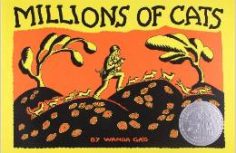THIRD READING: ANALYSIS – MILLIONS OF CATS
During this reading, your child and you have prior knowledge of how the text and illustrations fit together. Now, your interaction with the story will move to a higher level of thinking. The activities and questions below are considered “higher order thinking.” Activities and questions like these give the brain practice in being open to new ideas and creative thinking habits. Open-ended questions strengthen the brain by building new synapses (connections that increase our recall and retention).
For this reading you have the choice of how you read the story:
~reversing roles. Your child tells/”reads” the story, and you become the listener and questioner.
~ alternating the reading of pages with your child.
~pausing to allow your listener to fill in the next word or complete the sentence.
DISCUSSION QUESTIONS:
~Is this story a fairy tale?
Fairy tales are a kind of story that usually begin with “Once upon a time…..” and end with “they lived happily ever after.” Fairy tales usually have a problem that the characters solve. Fairy tales frequently have talking animals.
~If so, can we think of other fairy tales like Millions of Cats?
~The very old man wanted to pick a beautiful cat for the very old woman. Then, the cats quarreled over which cat was the prettiest. Is that the way that you would choose a cat? Is beauty the most important characteristic when picking a pet? How would you describe beauty?
~Was the very old man’s and the very old woman’s solution for picking a cat a good one? How would you have decided on which cat to keep?
~Discuss the math words: hundreds, thousands, millions, billions, and trillions. Can you and your child think of anything that there are hundreds of, thousands of, millions of, billions of, or trillions of?
ACTIVITIES:
~Below is a very simple graphic organizer, a visual way to organize information.
Each column represents a quantity. Have your child put marks such as x’s, dots, or tally marks to represent the quantities. Having an exact number isn’t important. In the hundreds column, there should be quite a few dots. In the thousands column, there should be many more than in the hundreds column. Continue with each column having many more than the previous column. Our goal is to illustrate that each word starting with hundreds is many dots, but less than thousands. Thousands is a larger number of dots, but less than millions. Each column is to have more dots than the previous column. Stress the order of: hundreds, thousands, millions, billions, trillions.
HUNDREDS, THOUSANDS, MILLIONS, BILLIONS, TRILLIONS
Read more...
